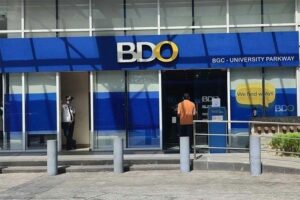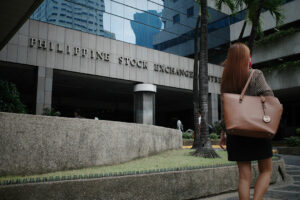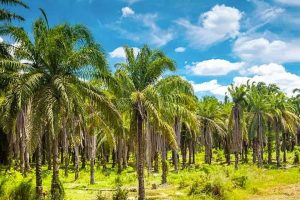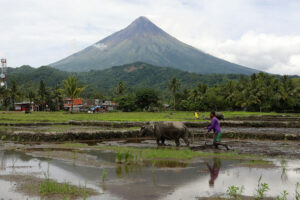BDO UNIBANK, Inc. was one of the most actively traded stocks in the local market last week after disclosing its second-quarter earnings and latest offering of peso-denominated sustainability bonds.
Data from the Philippine Stock Exchange (PSE) showed that BDO was the third most actively traded stock last week, with 18.71 million shares worth a total of P2.73 billion traded from July 28 to Aug. 1.
At the end of the trading week, BDO closed at P143 per share, down 6% from the previous Friday’s close of P152.20.
The decline was also reflected in the financial sector, which fell by 2.7%, while the benchmark PSE index (PSEi) contracted by 1.7% week on week.
Year to date, the stock contracted slightly by 0.7%, a reversal from the financial sector’s 1.6% growth but better than the PSEi’s 3.4% decline.
Regina Capital Development Corp. Head of Sales Luis A. Limlingan said in a Viber message that the various news surrounding BDO drove investors to trade more actively.
“Some investors may have had higher expectations for the earnings, prompting them to take profits. In contrast, others might have viewed the oversubscribed bond issuance as a potential catalyst for BDO in the remaining months of the year,” said Mr. Limlingan.
Mr. Limlingan added that investors are still digesting BDO’s earnings report, as the increase in net income for the first half of 2025 is relatively modest compared to its growth from the first half of 2023 to the first half of 2024.
“This could weigh on investors’ sentiment. However, investors might view the recent decline in price as a bargain opportunity,” said Mr. Limlingan.
“BDO reported a flat income, up only 3% for the first half of 2025, though its revenue increased by almost 10% and its net interest margin rose by five basis points quarter-on-quarter. Also, gross loans were up by double digits broadly across all segments, and management expects to sustain the pace of loan growth going into the rest of the year,” said Aniceto K. Pangan, equity trader at Diversified Securities, Inc.
Mr. Pangan added that the bottom-line income was affected by the increase in operating expenses due to expanded market coverage such as branch expansion and higher business volumes, together with investments in information technology infrastructure supportive of maintaining growth momentum.
“Cost of this growth is expected to decelerate going forward. Also, provision for credit losses increased by 38% in the second quarter but it’s within expectation with annualized credit cost a bit down when compared to last year with nonperforming loan improving to 1.75% from 2% at second quarter,” added Mr. Pangan.
The Sy-led bank’s attributable net profit stood at P20.91 billion in the first quarter, almost flat from its P20.94-billion net income in the same period last year. This brought its attributable income to P40.62 billion for the first half of the year, a 3% increase from P39.44 billion posted in the same period last year.
Meanwhile, BDO’s net interest income in the second quarter picked up by 8.3% to P50.38 billion from P46.51 billion a year earlier.
Net interest margin inched down to 4.3% as of June from 4.34% a year ago amid lower rates due to the central bank’s monetary easing cycle and “competitive market pricing.”
Customer loans and total deposits in the first half rose to P3.48 trillion and P4.03 trillion, respectively.
BDO’s assets expanded to P5.13 trillion at end-June amid higher customer loans and were mainly funded by deposits.
In a disclosure last week, BDO raised P115 billion for its fourth peso-denominated ASEAN Sustainability Bond issue, twenty-three times oversubscribed against the original offer of P5 billion.
The bonds have a tenor of 1.5 years and carry a coupon rate of 5.875% per annum.
They were sold at a minimum investment amount of P500,000 and in additional increments of multiples of P100,000 thereafter.
The public offering for the bonds was first set to run from July 9 to 22 but was closed earlier than planned because of strong demand.
The net proceeds of the issuance are aimed at financing or refinancing eligible assets as defined in the bank’s Sustainable Finance Framework, supporting the bank’s lending activities, and diversifying the bank’s funding sources, BDO said in a disclosure.
“With the successful fundraising of P115 billion from the original offer of P5 billion for the ASEAN Sustainability Bond at twenty-three times oversubscription, you could expect further growth in BDO from these sectors as it encompasses broad-based key industries for the nation, fostering sustainable growth and inclusive development in the country,” said Mr. Pangan.
“This issuance would increase the bank’s liquidity, and if all goes well, like inflation and interest rates being in the business’ favor, it could provide a profit boost from the spreads generated through this successful offering. It may also support their plan in expanding their market coverage,” said Mr. Limlingan.
Given the first half earnings, Mr. Pangan expects better growth momentum going into the second semester as operating expenses are expected to decelerate with operating efficiencies further improving as support for growth was laid down in the first half of the year.
“Expect revenues to further improve at double digits going into the rest of the year,” said Mr. Pangan. Though Mr. Pangan did not give a revenue forecast for the year after President Donald J. Trump set a 19% tariff on Philippine goods, which has put a lot of uncertainties on global growth and economic activities.
Mr. Pangan gave immediate support of P142 per share, while immediate resistance is at P154.80 per share.
Mr. Limlingan said that BDO remains the largest bank in the country in terms of asset size.
“However, several factors could affect BDO if the Bangko Sentral ng Pilipinas implements further rate cuts this year. This could put downward pressure on its net interest margin and may force the bank to adjust its pricing, especially if competition from other banks intensifies,” Mr. Limlingan said.
Mr. Limlingan pegged support and resistance levels at P142.68 per share and P153.83 per share, respectively. — Lourdes O. Pilar






